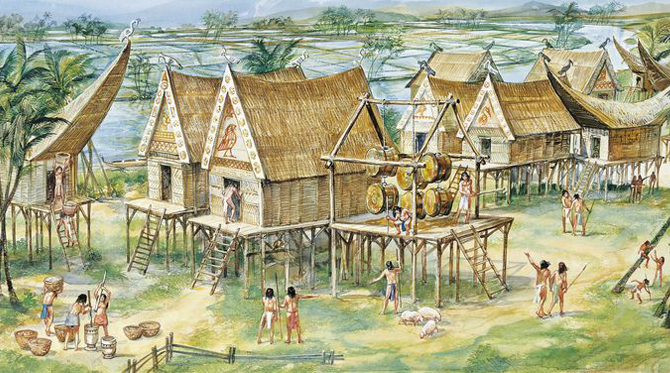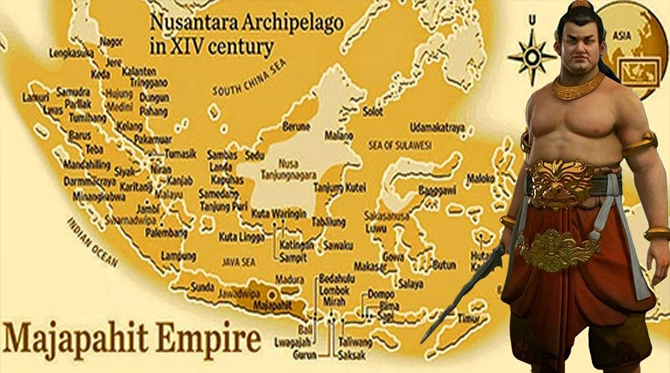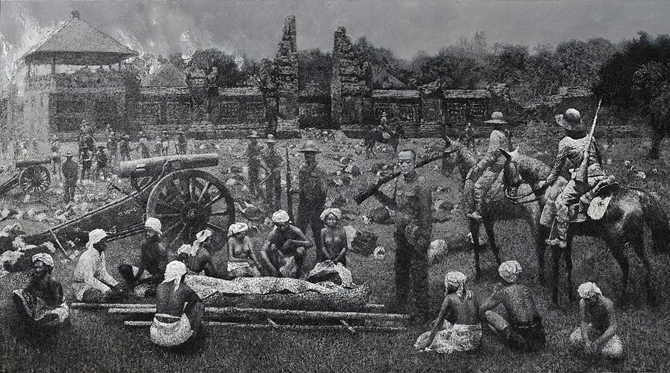BALI HISTORY
The history of Bali covers a period from the Paleolithic to the present, and is characterized by migrations of people and cultures from other parts of Asia.
In the 16th century, the history of Bali started to be marked by Western influence with the arrival of Europeans, to become, after a long and difficult colonial period under the Dutch, an example of the preservation of traditional cultures and a key tourist destination.

Bali being part of the Sunda shelf, the island had been connected to the island of Java many times through history. Even today, the two islands are only separated by a 2.4 km Bali Strait.
The ancient occupation of Java itself is accredited by the findings of the Java man, dated between 1.7 and 0.7 million years old, one of the first known specimens of Homo erectus.
Bali also was inhabited in Paleolithic times (1 my BCE to 200.000 BCE), testified by the finding of ancient tools such as hand axes were found in Sembiran and Trunyan villages in Bali.
A Mesolithic period (200.000-30.000 BCE) has also been identified, characterized by advanced food gathering and hunting, but still by Homo Erectus.
Neolithic: Austronesian migrations (3000-600 BCE)
From around 3000 to 600 BCE, a Neolithic culture emerges, characterized by a new wave of inhabitants bringing rice-growing technology and speaking Austronesian languages.
These Austronesian peoples seem to have migrated from South China, probably through the Philippines and Sulawesi. Their tools included rectangular adzes and red slipped decorated pottery.

Forests and jungles were cleared for the establishment of cultures and villages.They also made some plaited craft and a small boat was also found.
Their culinary habits included pork-eating and betel-chewing. They are thought to have focused on mountain cults.
They buried some of their more prestigious dead in oval stone sarcophagi, with human heads or zoomorphic figures sculpted on them. The bodies were either deposited in the sleeping position, or folded in two or three for compactness.
An important neolithic archaeological site in Bali is that of Cekik, in the western part of the island.
These same Austronesian people are thought to have continued their expansion eastward, to occupy Melanesian and Polynesian islands around 2000 years ago.
The cultural traits of this period are still clearly visible in the culture of Bali today, and connect it to the cultures of Southeast Asia and the Pacific Ocean.
Bronze Age: arrival of Dong Son culture (600 BCE-800 CE)
A Bronze Age period follows, from around 600 BCE to 800 CE. Between the 8th and 3rd century BCE, the island of Bali acquired the "Dong Son" metallurgical techniques spreading from Northern Vietnam.
These techniques involved sophisticated casting from moulds, with spiral and anthropomorphic motifs.

As mould fragments have been found in the area of Manuaba in Bali, it is thought that such implements were manufactured locally rather than imported.
The raw material to make bronze (copper and tin) had to be imported however, as it is not available on Bali.
Numerous bronze tools and weapons were made (axes, cooking tools, jewellery), and ceremonial drums from that period are also found in abundance, such as the "Moon of Pejeng", the largest ceremonial drum yet found in Southeast Asia, dated to around 300 BCE.
The stone sarcophagi were still in use during that period, as bronze artefacts were also found in them.
Ancient historical period: Indianized kingdoms (800-1343 CE)
The ancient historical period is defined by the appearance of the first written records in Bali, in the form of clay pallets with Buddhist inscriptions.
These Buddhist inscriptions, found in small clay stupa figurines (called "stupikas") are the first known written inscriptions in Bali and date from around the 8th century CE.
Such stupikas have been found in the regency of Gianyar, in the villages of Pejeng, Tatiapi and Blahbatuh.
This period is generally closely associated with the arrival and expansion of Buddhism and Hinduism in the island of Bali.
The Belanjong pillar ("Prasasti Blanjong") in southern Sanur was inscribed in 914 with the mention of the reign of the Balinese king Sri Kesari.
It is written in both the Indian Sanskrit language and Old Balinese language, using two scripts, the Nagari script and the Old Balinese script (which is used to write both Balinese and Sanskrit).
The pillar testifies to the connections of Bali with the Sanjaya Dynasty in Central Java. It is dated according to the Indian Shaka calendar.
According to the inscription, Sri Kesari was a Buddhist king of the Sailendra Dynasty leading a military expedition, to establish a Mahayana Buddhist government in Bali.
The stone temple of Goa Gajah was made around the same period, and shows a combination of Buddhist and Hindu (Shivaite) iconography.

Inter-marriages between Java and Bali royalty also occurred, as when king Udayana Warmadewa of the Warmadewa dynasty of Bali married a Javanese princess, sister of the Emperor of Java Dharmawangsa.
Their son became the great ruler of East Java Airlangga, who ruled on both Java and Bali. In the 12th century, descendant of Airlangga are also known to have ruled over Bali, such as Jayasakti (1146–50) and Jayapangus (1178–81).
The island of Java again started to encroach significantly on Bali with the invasion of Singarasi king Kertanegara in 1284.
Kertanegara was then toppled by Raden Wijaya, founder of the Majapahit Empire. Contacts with China were also important during this period. Chinese coins, called Kepeng were in use in Bali from the 7th century.
The traditional Barong is also thought to be derived from the Chinese dragon. In the 12th century, king Jayapangus of Bali is known to have married a Chinese princess.
Middle historical period: Majapahit dynastic rule (1343-1846)
The Majapahit Empire rule over Bali became complete when Gajah Mada, Prime Minister of the Javanese king, defeated the Balinese king in Bedulu in 1343.
The Majapahit capital in Bali was established at Samprangan and later Gelgel. Gelgel remained the paramount kingdom on Bali until the second half of the 17th century.

The rule of the Majapahit marks the strong influx of Javanese culture into Bali, most of all in architecture, dance and the theatre, in literature with the introduction of the Kawi script, in painting and sculpture and the wayang puppet theatre.
The few Balinese who did not adopt this culture are still known today as "Bali Aga" ("Original Balinese") and still live in a few isolated villages.
With the rise of Islam in the Indonesian archipelago, the Majapahit empire finally fell, and Bali became independent at the end of the 15th or beginning of the 16th century.
According to some myth the Javanese aristocracy fled to Bali, bringing an even stronger influx of Hindu arts, literature and religion.
According to later chronicles the dynasty of Majapahit origins, established after 1343, continued to rule Bali for 5 more centuries until 1908, when the Dutch eliminated it in the Dutch intervention in Bali (1908).
In the 16th century, the Balinese king Dalem Baturenggong even expanded in turn his rule to East Java, Lombok and western Sumbawa.
Around 1540, together with the Islamic advance, a Hindu reformation movement took place, led by Dang Hyang Nirartha, leading to the introduction of the Padmasana shrine in honour of the "Supreme God" Acintya, and the establishment of the present shape of Shiva-worshipping in Bali.
Nirartha also established numerous temples, including the spectacular temple at Uluwatu.
In ancient Bali, nine Hindu sects existed, namely Pasupata, Bhairawa, Siwa Shidanta, Waisnawa, Bodha, Brahma, Resi, Sora and Ganapatya. Each sect revered a specific deity as its personal Godhead.
Inscriptions from 896 and 911 do not mention a king, until 914, when Sri Kesarivarma is mentioned. They also reveal an independent Bali, with a distinct dialect, where Buddhism and Sivaism were practiced simultaneously.
Mpu Sindok's great-granddaughter, Mahendradatta (Gunapriyadharmapatni), married the Bali king Udayana Warmadewa (Dharmodayanavarmadeva) around 989, giving birth to Airlangga around 1001.
This marriage also brought more Hinduism and Javanese culture to Bali. Princess Sakalendukirana appeared in 1098. Suradhipa reigned from 1115 to 1119, and Jayasakti from 1146 until 1150.
Jayapangus appears on inscriptions between 1178 and 1181, while Adikuntiketana and his son Paramesvara in 1204.
Balinese culture was strongly influenced by Indian, Chinese, and particularly Hindu culture, beginning around the 1st century AD.
The name Bali dwipa ("Bali island") has been discovered from various inscriptions, including the Blanjong pillar inscription written by Sri Kesari Warmadewa in 914 AD and mentioning Walidwipa.
It was during this time that the people developed their complex irrigation system subak to grow rice in wet-field cultivation. Some religious and cultural traditions still practiced today can be traced to this period.
The Hindu Majapahit Empire (1293–1520 AD) on eastern Java founded a Balinese colony in 1343. The uncle of Hayam Wuruk is mentioned in the charters of 1384–86.
A mass Javanese immigration to Bali occurred in the next century when the Majapahit Empire fell in 1520.
Bali's government then became an independent collection of Hindu kingdoms which led to a Balinese national identity and major enhancements in culture, arts, and economy.
The nation with various kingdoms became independent for up to 386 years until 1906, when the Dutch subjugated and repulsed the natives for economic control and took it over.

European contacts
The first direct or indirect news of Bali by some European travelers can be traced back to Marco Polo and other possible travelers and traders via the Mediterranean Sea and Asia.
The first known European contact with Bali is thought to have been made in 1512, when a Portuguese expedition led by Antonio Abreu and Francisco Serrão reached its northern coast.
It was the first expedition of a series of biannual fleets to the Moluccas, that throughout the 16th century usually traveled along the coasts of the Sunda Islands.
Bali was also mapped in 1512, in the chart of Francisco Rodrigues, aboard the expedition.
The Magellan expedition (1519–1522), through Elcano, is thought to have possibly sighted the island, and early Portuguese and Spanish charts mention the island under various names such as Boly, Bale and Bally.
Sir Francis Drake briefly visited the island in 1580. In 1585, the Portuguese government in Malacca sent a ship to establish a fort and a trading post in Bali, but the ship foundered on the reef of the Bukit peninsula and only five survivors could make it ashore.
They went into the service of the king of Gelgel, known as the Dalem, and were provided with wives and homes. In 1597, the Dutch explorer Cornelis de Houtman arrived in Bali with 89 surviving men (out of 249 who had departed).
After visits to Kuta and Jembrana, he assembled his fleet in Padang Bai. Enthusiastic, he christened the island "Young Holland" (Jonck Hollandt).
They were able to meet with the Dalem, who produced for them one of the Portuguese who had been in his service since 1585, Pedro de Noronha.
Bali Indonesian Independence
Imperial Japan occupied Bali during World War II with the declared objective of forming a "Greater East Asian Co-Prosperity Sphere" that would liberate Asian countries from Western domination.
The harshness of war requisitions made Japanese rule more resented than Dutch rule. Most of all, independence was strongly desired among the populace.
Following Japan's Pacific surrender in August 1945, the Balinese took over the Japanese weapons. The Dutch returned to Indonesia in 1946, including Bali, to reinstate their pre-war colonial administration.

One Balinese, Colonel Gusti Ngurah Rai, formed a Balinese 'freedom army'. Colonel I Gusti Ngurah Rai, by then 29 years old, rallied his forces in east Bali at Marga Rana, where they were trapped by heavily armed Dutch troops.
On 20 November 1946, in the Battle of Marga, the Balinese battalion was entirely wiped out, breaking the last thread of Balinese military resistance.
In 1946 the Dutch constituted Bali as one of the 13 administrative districts of the newly proclaimed State of East Indonesia, a rival state to the Republic of Indonesia which was proclaimed and headed by Sukarno and Hatta.
Bali was included in the United States of Indonesia when the Netherlands recognised Indonesian independence on 29 December 1949.
The first governor of Bali, Anak Agung Bagus Suteja, was appointed by President Sukarno in 1958, when Bali became a province.
